CEES 2011 Brings an unique idea
about Green Energy
Leading experts and leaders of the World and Chinese autuority advocated the establishment of space stations and development of bio-energy
Secretariat of China Energy and Environment Summit
International Energy and Environment Institute, UIBE
 
Joint sponsored by the National Development and Reform Commission, the State Energy Bureau, Ministry of Science and Technology, Ministry of Environment Protection and Ministry of Land and Resources, China Energy and Environment Summit (CEES) has been successfully held for three sessions since 2008. Joint organized by University of International of Business and Economics, China Academy of Space Technology, Space Energy Group, Department of Chemical Engineering, Tsinghua University, CEES 2011 was held on Aug. 28-29, 2011 in UIBE, Beijing, China. The summit invited about 160 government officials from National Energy and Environment Administrations, domestic and international top-level experts and scholars to extend a discussion in depth on China's High-tech and new energy and space technology, Energy Conservation and Environment Protection and reach a consensus.
Chinese energy and environmental authority and world’sLeading scientists and leaders pay close attentionTo promote the new green energy vision
The theme of the summit was High and New Energy, Energy Conservation and Environment Protection. The summit lasted for two days. Participated experts and scholars made research and discussions about the following five topics:
Strategy and planning of high-tech and new energy development, development and application of high-tech clean energy; comparative analysis on high-tech and new energy and space technology industrialization prospects; green economy, energy conservation and environment protection \ financing of new energy, energy conservation and environment protection; and technology development and application study of biologic energy.
The CEES 2011 Conference Proceedings has been published, which included introductions to Chinese and foreign speakers, papers and abstracts, and pre-correspondent reports. LIN Guijun(below,right photo ), Vice President of University of International of Business and Economics, chaired the conference.
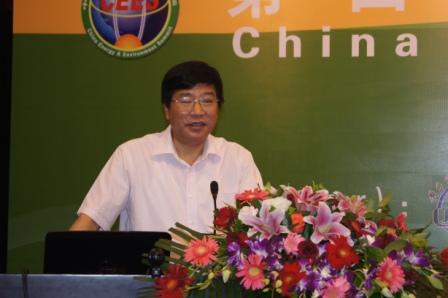 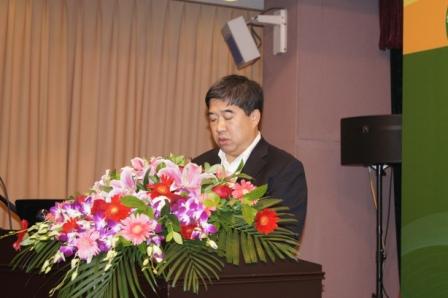
Professor SHI Jianjun(above, left photo), President of University of International Business and Economics, HeE Bingguang, Deputy Director- general & Inspector of Department of Resource Conservation and Environment Protection of NDRC, Dr. A.P.J.Abdul Kalam, the Former President of the Republic of India, the world’s leading aerospace scientist, and Dr. Mark Hopkins, the Chief Executive Officer of the National Space Society, made speeches on the opening ceremony.
President SHI introduced the outstanding achievements of UIBE in energy-saving and ejection-decreasing in recent years. With total well-performed 22 energy-saving and ejection-decreasing programs since 2003, UIBE has been spoken highly of by society and been the example of other colleges and universities. He said UIBE would continue to make contributions to energy saving and environmental protection.
Mr. HE Bingguang(below,left photo) made a speech titled Industry Support of China’s Green Economic Development affirming the significant role of space based solar power and bio-energy in the future. He said that developing green industry is a global consensus under the background of deterioration of global environment. Space solar power and biologic energetic had promising prospect and would be important supports of green economy in the future. The summit had deep and further influence on the development of new energy and green economy.
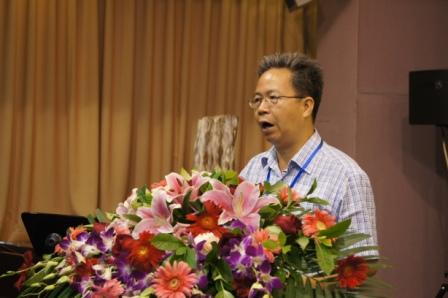 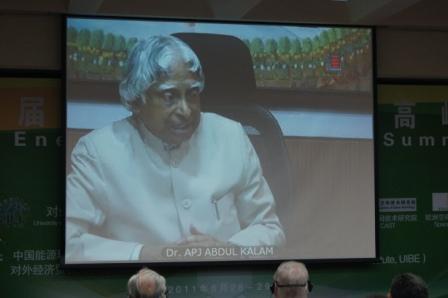
Dr. A.P.J.Abdul Kalam (above, right photo)delivered a video speech. He said “ I am delighted to address the Opening Ceremony of the 4rd China Energy and Environment Summit. I congratulate the organizers of this Summit for their devoted and dedicated efforts to bring together eminent leaders and experts on a common platform for exchange of views, for high-level dialogue and discussions on a topic of profound importance to all humanity. It is essential that the energy policy of the nations and clean environment for the planet earth have to be integrated in our thoughts and actions. I am sure, CEES will achieve this goal during the deliberations of this summit. In the speech, he described the prospect of space based solar power in 2050 and called for closer international cooperation in new energy.
SHI Lishan(below,left photo), Director of New Energy and Renewable Energy of National Energy Administration, made a report of Development of China’s High-tech and New Energy. His speech detailed the prospect and strategic planning of China’s high-tech and new energy. He said this was his first time listening to a lecture themed space solar energy in formal conference. He pointed out that using new energy was an important way for Chinese industrial development. However, the popularization of new energy was limited by high-cost. He hoped the participated experts made useful proposals for the development of new energy in China.
 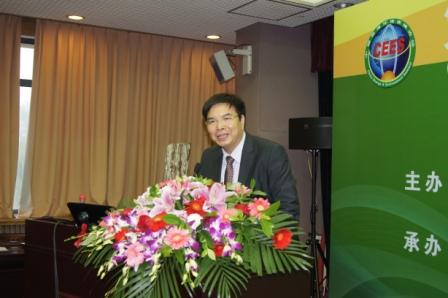
ZHAO Zhongxiu(above,right photo), Vice President of University of International of Business and Economics made congratulations to the success of the 4th China Energy & Environment Summit, pay tribute to all the participated experts and scholars, and congratulations on the CEES Secretariat's outstanding organization. He said that technology leads to the prosperous future which the experts described in their speech. The combination of commercial interests and public interests needs hard cooperation among scientists, economists and officials. As a social science-based university, we hope to cooperate with scientists as to make contributions to policy and resources distribution.
LIN Zhiqin(below,right photo), Secretary General of CEES, Professor of UIBE, Director of International Energy and Environmental Institute, made the Comprehensive Report of 2011 Chinese Energy and Environmental Development, which mainly analyze the utility of solar power, space solar power, biology energy and nuclear energy and the future of new energy. It is said that green energy is an important industry support of the sustainable development of world economy. China should develop wide international cooperation in this field. The report will be published after the summit, which will provide related policy suggestions and promote the international cooperation of environmental economy and technology.
 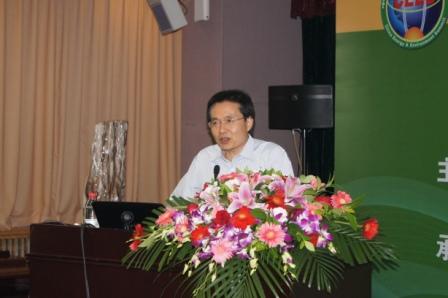
Keynotes reports were chaired separately by Professor SANG Baichuan(above,left photo), Dean of International Economic Institute of UIBE, etc.
World’s leading experts put forward proposals for the technology of space solar power and biologic energy
Many world’s leading experts and scholars made professional reports in the summit. Professor LI Ming(below,left photo), Vice-president of Chinese Academy of Space Technology (the 5th branch), and Feng Hsu(below,right photo), Senior Vice President of Space Energy Group, chaired the high-tech and new energy session.
 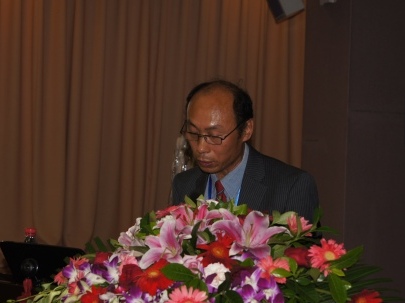
On the problem of solar power and space solar power development, Prof. LI Ming, Deputy President of CAST, made a speech titled The Development and Utilization of Clean Energy -- Space Solar Power and Relevant Space Technologies. He said, “…the importance of environmental protection and new energy sources were becoming the consensus of the world. However, building a space power satellite is facing serious technical, economic and production challenges in China…. It's proposed that several technologies need to carry out specially, including space solar power technology, wireless power transmission technology, in-orbit assembly of large structures and maintenance technology, space transportation technology.”
CAS Academician WANG Xiji (below,left photo)and MIN Guirong (below,right photo)made speeches about Development Prediction and Countermeasures of Space Solar Power Plant Technology. They said that utilizing space solar resources by the construction of space solar power station (SSPS) in geosynchronous orbit will be a feasible and effective response to the global energy crisis and climate change. SSPS, in the foreseeable future, will be the largest and heaviest artificial space infrastructure. A lot of research, development, testing and validation need to be done to reach the level of SSPS development and building. The development of SSPS must first focus on security issues, and the initial scale of SSPS should be available. The scale is recommended to be built in about 2030s. Second, it's essential to pay special attention to some key technologies, such as heavy-payload space transportation, efficient wireless power transmission, assembly and maintenance. It's recommended that the National Development and Reform Commission is responsible for the development of SSPS and carry out in three-step. The entire SSPS testing and validation will be achieved in about 2030.
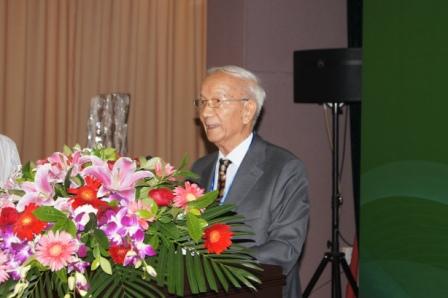 
Professor WANG Zhifeng, Director of Solar Thermal and Photovoltaic Systems Laborator of Institute of Electrical Engineering of CAS, reported technical path of concentrated solar thermal power. Mr. HUANG Maka from School of Electronics and Information Engineering, Sichuan University, reviewed the history of microwave power transmission and prospected its future. Paul Werbos, Senior Assistant of U.S. Republican Senator, Program Director for Energy, Power and Adaptive Systems(EPAS), delivered a speech of Energy from Space: Strategy Opportunity and Concrete Challenges. Dr. Martin Hoffert from New York University made the cost comparison of Laser-transmitted Photovoltaic Electricity from Space Versus Terrestrial PV with Energy Storage.
Stephan Tennsel(below,left photo) , President of Space Energy AG introduced Worldwide Space Energy Locations; The 4 Space Energy AG Business Divisions--Space Based Solar Power, Space Energy PV R & D, Space Energy Minerals, Space Energy Terrestrial Parks; Space Energy Terrestrial Strategic Partners; Space Energy Terrestrial Summary Project Pipeline; SBSP: Necessary and Cost Effective Long Term Innovation. He said, “We are making it our business to harness the world’s most valuable asset, the Sun – planet earths original, and only, truly sustainable resource”.
 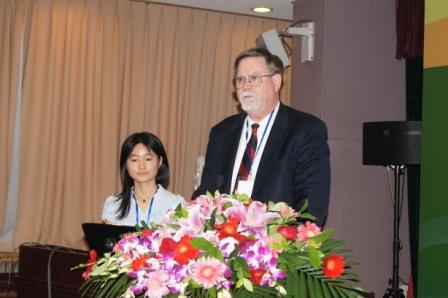
About space solar power and international cooperation, Mr. Mark Hopkins(above,right photo), CEO of the National Space Society, pointed that SSP was environmentally benign and in particular produced almost no carbon dioxide. Therefore, its widespread use would greatly mitigate the problem of climate change. However, much work needs to be done before the cost of such energy is reduced to a practical level. International cooperation could greatly accelerate this process. Consequently, Dr. Kalam, the former President of India, and NSS have joined together to create the Kalam -- NSS Initiative, which is aimed at stimulating a bilateral SSP program in India and the United States. The early participation of other nations would be welcomed.
As for nuclear power, Dr. Feng Hsu, Sr. VP of SEG, former NASA Sr. Engineer & Technical Manager of USA, said that the largest in the European Union's aerospace company, EADS Atrium had officially announced that the company is committed to R&D of a large SPS program. He believed these decisions would prove to be wise. "It is my strong believe, as a risk-based decision-making expert that in the near future (after 30 years or so into this century or even within a shorter period of time), such strategic actions in investing in middle-to-long term technology development will surely lay a solid foundation for Japan and the EU in their economic competitiveness under the increasingly globalized world economy." He said.
Professor Chin Pan, Dean of Academy of Nuclear Science of National Tsinghua University at Hsinchu, Taiwan, gave a report about Cross-Strait Collaboration to Promote Nuclear Safety and Research on Generation IV Reactors. Ge Changchun, Member of Chinese Academy of Science, Professor of Beijing Science and Technology University, pointed out the importance of building nuclear fusion power station on the ground and solar power station in the space. Professor HUA Ruxing from School of Economic Management of Tsinghua University, Secretary General of China Financial Associate, expressed his different opinion. There was an argument on the conference.
Sergio C. Trindade, co-laureate of the Nobel Peace Prize for 2007, ask questions to Dr. A.P.J.Abdul Kalam via video. Professor WANG Xiji and Professor SHI Lishan are communicating.
JIA Baohua and TANG Bi, YU Qing, from UIBE, Researcher Zhao Xumei, Prof. WANG Li, and Dr. Hou Xinbin are communicating on the conference.
As for the problem of future energy option, Gustav R. Grob, Fellow of the Energy Institute F.EI, President of the International Clean Energy Consortium (ICEC), compared the prospects of different new and high-tech energies. Inn S. Kim, President of ISSA Technology, USA, introduced Dynamic Decision Making for Optimal Policies on Renewable and Sustainable Energy.
For the issue of biologic energy development, Sergio C. Trindade(below,left photo), as the former United Nations Assistant Secretary-General for Science and Technology and a 2007 Nobel Prize Co-Laureate, forecasted the importance of public policy for global production, consumption and trading of biologic energy in microscope view. He said, " China's growing energy appetite is met today largely by fossil fuels, domestic and imported. Domestic coal fuels most of electricity generation, despite efforts to diversify into natural gas, hydropower and the renewable such as wind power and solar." He proposed that a low fossil carbon energy system is helpful to arrest climate change and global warming. Technological innovation is the key to the future, especially by expanding the use of non-food feedstock. In the end, he said, "for sustainability to prevail, domestic biofuels production must co-exist with international trade." and "a North-South BioPact compound is crucial for sustainability to be achieved."
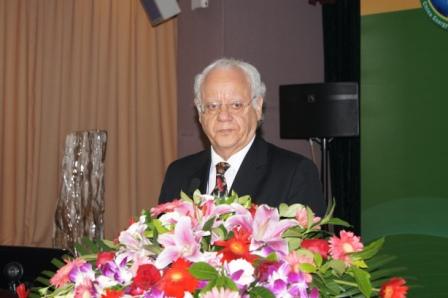 
As for the technology of biologic energy, Professor XING Xinhui(above,right photo), Chair of Department of Chemical Engineering of Tsinghua University, analyzed the opportunities and challenges of production technology of gas biofuels BioHythane by low-grade biomass. He thought that developing methodology for the design / optimization of metabolic pathways and microbial consortia capable of realizing the efficient utilization of the low-grade biomass resources was of great importance. Professor ZHAO Lixin, General-director of Energy and Environmental Protection Institute of Ministry of Agriculture, made a detailed introduction to the status and problems of application of biogas technology in China. Professor LONG Minnan, Executive Vice-Dean of School of Energy Research of Xiamen University, delivered a speech about Cellulosic biomass for liquid biofuels. Professor CHENG Xiansu, Director of College of Materials Science and Engineering of Fuzhou University, reported recent progress of research on enzymatic hydrolysis lignin. Professor FANG Xu, Director of State Key Laboratory of Microbial Technology of Shandong University, presented the progress and challenge on enzymatic saccharication of lignocellulosic biomass. Besides, Professor LIU Bin, Director of Institute of Bioenergy and College of Food Science of Fujian Agriculture and Forestry University, analyzed the key bottleneck in tech industrialization of cellulosic ethanol and the solution.
Many experts and scholars made deep discussions about the development and application of high-end clean energy, technology development and application study of biologic energy, the prospects of different new energies, and the cooperation mechanism. We hope participants’ good proposals will benefit the development of high-tech energy and biologic energy in China.
Reported by LIN Hongshan, Fudan University ect.
Translated by WANG Qian from SIS, UIBE
· Examined and verified by Prof. LIN Zhiqin, CEES
|